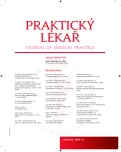What is „third-hand smoke“?
Authors:
D. Hrubá 1; V. Šikolová 1,2
Authors‘ workplace:
Masarykova univerzita, Brno
Lékařská fakulta
Ústav preventivního lékařství
Přednostka: prof. MUDr. Bc. Zuzana Derflerová Brázdová, DrSc.
1; Mezinárodní centrum klinického výzkumu
Fakultní nemocnice u sv. Anny, Brno
2
Published in:
Prakt. Lék. 2014; 94(4): 190-194
Category:
Of different specialties
Overview
Health professionals have been describing the danger of second-hand smoke for decades and many countries have created the legislative norms protecting no-smokers against their involuntary exposure to passive smoking. Now a growing number of scientists is interested in the “third-hand smoke” (THS), residues of tobacco smoke that remain in the indoor air and surfaces for hours, weeks, months, when cigarettes are extinguished. The sources of chemicals involved into the THS are the components emitted from the burning tobacco (mainly nicotine), but also obvious parts of indoor air (ozone, nitrous acid, nitrogen oxides). These substances can produce new chemicals, such as tobacco-specific nitrosamines, volatile organic compounds and others, by their inter - reactions. Although the toxic, mutagenic and carcinogenic effects of THS are under investigation, the increasing public interest about the third-hand smoke could change attitudes to smoking and better protect non-smokers, especially children.
Keywords:
second-hand smoke – smoke aging – third-hand smoke – children exposure – prevention
Sources
1. Burton A. Does the smoke ever really clear? Third-hand smoke exposure raises new concern. Environ Health Perspect 2011; 119: a70–a74. Dostupné na: http://dx.doi.org/10.1289/ehp.119-a70.
2. Ferrante G, Simon M, Cibella F, et al. Third-hand smoke exposure and health hazards in children. Monaldi Arch Chest Dis 2013; 79 : 38–43.
3. Fortmann AL, Romero RA, Sklar M, et al. Residual tobacco smoke in used cars: futile efforts and persistent pollutants. Nicotine Tob Res 2010; 12 : 1029–1036.
4. Hrubá D, Matějová H, Žaloudíková I. Jak chránit děti před expozicí pasivnímu kouření v jejich domovech. Hygiena 2010; 55 : 86–91.
5. International Agency for Research on Cancer. IARC monographs on the evaluation of carcinogenic risks to humans: smokeless tobacco and some tobacco-specific N-nitrosamines. Lyon (France): 2007, 89.
6. Matt GR, Quintana PJ, Zakarian JM, et al. When smokers move out and non-smokers move in: residential thirhand smoke pollution and exposure. Tob Control 2011; 20(1): e1.
7. National Research Council. Science and Decisions: Advancing Risk Assessment/ Committee on Improving risk analysis approaches used by the U.S. EPA, Board on Environmental Studies and Toxicology, Division on Earth and Life Studies. Washington, DC: National Academic Press 2009.
8. Rabinoff M. Pharmacological and chemical effects of cigarette additives. Am J Publ Health 2007; 97(11): 1981–1991.
9. Schick SF, Glantz S. Concentrations of the carcinogen NNK in sidestream cigarette smoke increase after release into indoor air: Results from unpublished Tobacco Industry Research. Cancer Epidemiol Biomarkers Prev 2007; 16 : 1547–1553.
10. Schick SF, Farraro KF, Perrino Ch, et al. Thirdhand cigarette smoke in an experimental chamber: evidence of surface deposition of nicotine, nitrosamines and polycyclic aromatic hydrocarbons and de novo formation of NNK. Tob Control 2013 May 28; [Epub ahead of print]. doi: 10.1136tobaccocontrol-2012-050915.
11. Singer BC, Coleman BK, Destaillats H, et al. Indoor secondary pollutants from cleaning products and airfreshener use in the presence of ozone. Atmos Environ 2006; 40 : 6696–6710.
12. Sleiman M, Gundel LA, Pankow JP, et al. Formation of carcinogens indoors by surface-mediated reactions of nicotine with nitrous acid, leading to potential third-hand smoke hazards. Proc Natl Acad Sci USA 2010; 107 : 6576–6581.
13. U.S. Environmental Protection Agency. Child Specific exposure factors Handbook (Final Report). US EPA, National Center for Environmental Assessment, Office of Research and Development, Washington, D.C.: 2008. Dostupné z: http://cfpub.epa.gov/ncea/cfm/recordisplay.cfm?deid=199243.
14. U.S. Surgeon General Report. Office on Smoking and Health. The health consequences of involuntary exposure to tobacco smoke. A Report of the Surgeon General. Atlanta: Centers for Disease Control and Prevention, 2006. Dostupné z: http://www.surgeongeneral.gov/library/reports/secondhandsmoke/index.html.
15. Wilson KM, Klein JD, Blumkin AK, et al. Tobacco-smoke exposure in children who live in multiunit housing. Pediatrics 2011; 127 : 85–92.
16. Winickoff JP, Friebely J, Tanski SE, et al. Beliefs about the health effects of „thirhand“ smoke and home smoking bans. Pediatrics 2009; 123: e74–79.
17. World Health Organization. WHO Framework Convenion on Tobacco Control. Geneva, WHO 2003. Dostupné z: http://whqlibdoc.who.int/publications/2003/9241591013.pdf.
18. World Health Organization. WHO Report of the Global Tobacco Epidemic, 2009. Implementing Smoke-Free Environments. Geneva, WHO 2009. Dostupné z: http://whqlibdoc.who.int/publications/2009/9789241563918_eng_full.pdf.
19. Zhou X, Sheng Y, Yang R, Kong X. Nicotine promotes cardiomyocyte apoptosis via oxidative stress and altered apoptosis-related gene expression. Cardiology 2010; 115 : 243–250.
Labels
General practitioner for children and adolescents General practitioner for adultsArticle was published in
General Practitioner

2014 Issue 4
Most read in this issue
- Arthritis of the wrist and possibilities of surgical treatment
- Pre-operative assessment and pre-operative preparation in lung surgery
- Posttraumatic stress disorder
- What is „third-hand smoke“?
